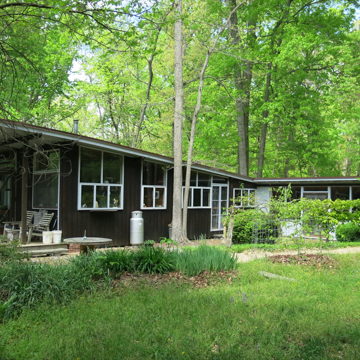Architect Wagner moved to the Washington area to work for the WPA, and starting in 1936 he was a frequent guest at Hard Bargain Farm. After World War II, Wagner and his wife Nancy became pioneer residents of the Moyoane Reserve, purchasing a twelve-acre lot and building their modernist house over a period of several years. The one-story Wagner House is an informal composition of five low-slung sections with board-and-batten or window walls and a butterfly roof with wide overhanging eaves. Construction started with a one-room guesthouse and carport and then proceeded with the main house, which consisted of a bedroom, bath, kitchen, and dining room. A “children’s wing,” added in 1950, included a playroom and bedroom cubbies for the four Wagner children. The living room with window walls completed the house in 1951. Wagner went on to design seventeen unpretentious but modern custom houses on the large forested lots of the Moyaone Reserve between 1946 and 1978. His aesthetic vision of clean lines and an intimate connection with the natural features of each lot perfectly meshed with the overall environmental goals of the community.
You are here
WAGNER HOUSE
If SAH Archipedia has been useful to you, please consider supporting it.
SAH Archipedia tells the story of the United States through its buildings, landscapes, and cities. This freely available resource empowers the public with authoritative knowledge that deepens their understanding and appreciation of the built environment. But the Society of Architectural Historians, which created SAH Archipedia with University of Virginia Press, needs your support to maintain the high-caliber research, writing, photography, cartography, editing, design, and programming that make SAH Archipedia a trusted online resource available to all who value the history of place, heritage tourism, and learning.





















